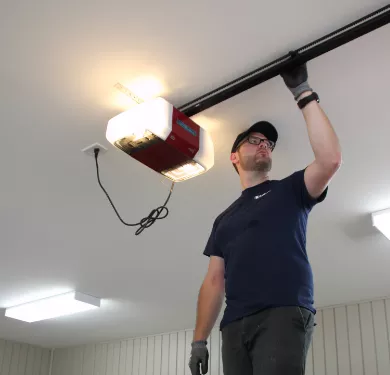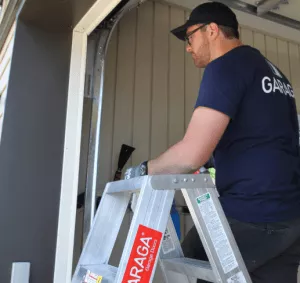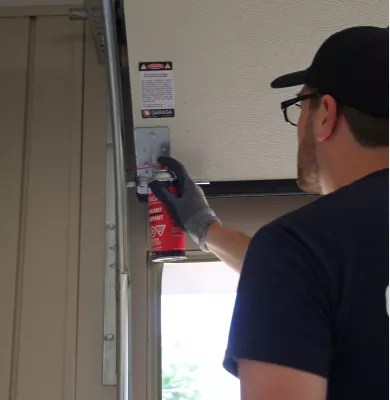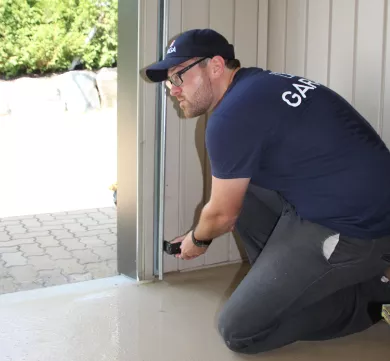Does your residential garage door need regular maintenance? Yes, it does. Like just about every other system in your house, your garage door and opener should receive a little bit of TLC throughout the year in order to stay in good working condition. It’s the only way to stave off more expensive repairs and replacements.
Your garage door is one of the largest and heaviest moving objects in your home. You cannot afford to take chances here. This is particularly true if you and your family frequently use the garage door to enter and leave the home. Really, it’s all about safety and security.

Ensuring your family is safe
Garage door malfunctions are responsible for a number of accidents and injuries each year, and almost all of those malfunctions could be prevented with a little bit of preventative maintenance. Just to give you an idea of how common this is, there were 18,000 such accidents in the US in 2014 alone.
What causes those accidents and malfunctions? In most cases, it came down to one of three issues:
- A component failure
- An imbalanced spring system (responsible for counterbalancing the weight of the door)
- Misadjusted calibration of one of the two automatic reversal systems (photoelectric or mechanical)
Thankfully, it’s pretty simple to avoid becoming yet another statistic. Just make sure that you visually inspect your garage door and opener regularly, and that you take the right steps to maintain and care for it over time.
What you need to do to maintain your door and opener
Not sure what you need to do to maintain your door? We’ve got you covered. We’ll go over everything necessary, step by step.
- How often? We recommend that you visually inspect your garage door at least twice per year, but more often if you use your door heavily (more than one cycle per day). Note that a cycle is one open and one close.
- When? Our recommendation is that you inspect and perform maintenance during spring and fall, before the extreme heat of summer and the cold of winter.
Your inspection
- Visually inspect all components, but also listen to the door/opener/track while it’s in operation. Do you notice anything out of the ordinary?
- Check the lift cables closely. They’re located within the vertical tracks. Any sign of wear and tear should prompt you to call for professional service.
- Check the cable drum. Is it aligned properly?
- Check your spring system. You’ll have either a torsion system or an extension system.
- Torsion – Located inside a steel tube mounted over the garage door
- Extension – Located within the steel door tracks on the ceiling

- When checking your springs, make sure nothing is broken or seriously damaged. Make sure there is no unusual noise during operation. Note that you should never, ever, try to repair or replace springs on your own. It can be life threatening. Always have a professional handle this for you.
- Give the rollers an eyeball. Do they look like they’re about to break off? Are they sliding instead of rolling?
- Check the hinges. Make sure the bolts are fully tightened and that the bottom brackets where the lift cables connect are in good shape.
- Go over the weatherstripping at the bottom and between the door sections. Do you notice small holes from wear that will let in inclement weather or pests?
- Check your photoelectric reversal system eyes for dust and dirt.
Lubricate it
- You’ll need two types of lubricant for your garage door. First, you’ll need engine oil. Something like 5W30 will work just fine. This is for use on all the metal parts of the garage door, including the track. You’ll also need a silicone‑based lubricant to help protect the weatherstripping. You can purchase both types of lubricant from Door Systems Metro Boston. However, before you apply new lubricant, make sure to remove old oil and grease.

Metal components
Here’s what you need to know about applying oil to your metal components.
- Springs: Just put a little oil on the springs, then wipe it off with a clean cloth.
- Rollers: A dab of oil will help them roll smoothly, but don’t apply so much that they slide.
- Hinges: Apply oil at the junction point.
- Tracks: Apply a small amount of oil at the curve of the track, and then along the horizontal portion.
Weatherstripping
Protecting your weatherstripping is simple.
- Exterior Frame: Apply lubricant all along the interior side of the weatherstripping.
- Door Sections: Apply lubricant on the full length of weatherstripping between door sections.
- Bottom: The entire U‑shaped piece on the bottom of the door should be protected with lubricant.
Test for safety
- Twice per year, you need to check that both automatic reverse systems are in good working condition. Some companies actually recommend a monthly test on these systems.
- To test the mechanical reverse system, place a 2x4 beneath the door, and then close it. The door should reverse as soon as it makes contact with the wood. If not, you need immediate service.
- To test the photoelectric system, close the door with your remote. While it is closing, pass your foot in front of one of the photo‑eyes to break the beam. The door should immediately reverse. If not, you need service.

- Note: If either of these systems fails, you need immediate professional service from Door Systems Metro Boston.
Want professional help?
If you’re too busy to maintain your garage door, or you simply want a professional on your side, we’re happy to help. All you need to do is call us. You can reach us at 1-800-545-3667. We would be happy to handle your maintenance needs, and we even offer a full tune‑up service to make sure that all of your components and systems are in good shape. If you think it’s time for a new garage door and opener, we can help, too. We’ll even send you an email quote if you like.

Add new comment